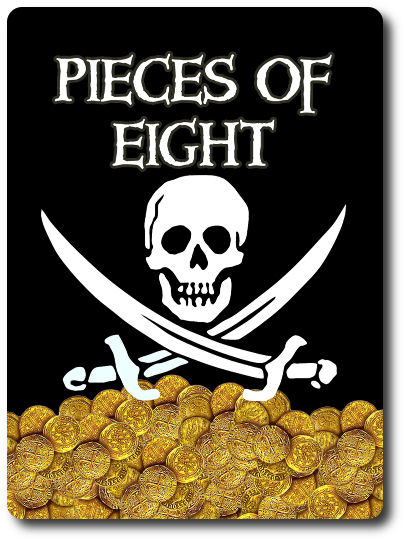
The Basics:
- For ages 8 and up (publisher suggests 12+)
- For 2 to 5 players
- Variable game length (30 to 60 minutes)
Geek Skills:
- Active Listening & Communication
- Counting & Math
- Logical & Critical Decision Making
- Reading
- Risk vs. Reward
- Hand/Resource Management
Learning Curve:
- Child – Easy
- Adult – Easy
Theme & Narrative:
- Raid and plunder as fast as you can so you can live to enjoy your stolen treasure
Endorsements:
- Gamer Geek approved!
- Parent Geek approved!
- Child Geek approved!
Overview
Every pirate captain’s wish is to earn enough gold to retire. Preferably before they lose a limb, or worse yet, are captured and hung. Be they men or women, these pirate captains know that there is much risk in their daring ventures, but the rewards are too tempting to ignore. If they get enough gold and make a big enough name for themselves, they can retire to a life of luxury. Death at sea is just one of the many risks they are willing to take!
Pieces of Eight – Steal the Booty! Drink the Rum!, by TalkingBull Games, is comprised of 1 Game deck (120 cards), 1 Captain deck (10 cards), 2 standard four-sided dice, 2 standard six-sided dice, 2 standard eight-sided dice, 25 red winks (small plastic chips), 40 plastic Pieces of Eight (gold coins), and one large cloth bag to put all the parts into. Note that the components listed here are part of the deluxe edition. The game play is the same as the standard edition of the game.
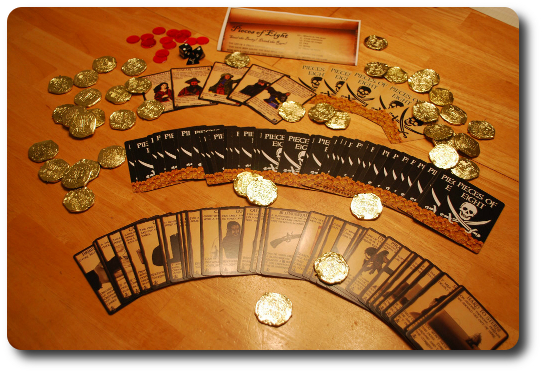
Make Ready to Sail!
To set up the game, first take the Captain deck and either allow every player to select a Captain card of their choice or deal one to each player randomly. Some of the Captain cards available include Edward Teach, William Kidd, and Henry Morgan. The Captain card is played directly in front of the player, face-up. Any Captain cards not selected or dealt are placed back in the game box.
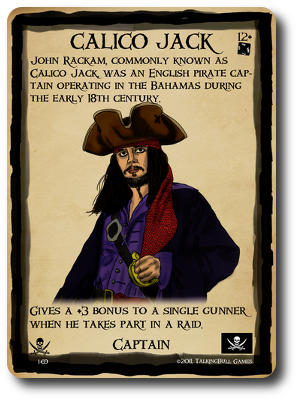
Second, look through the Game deck and give to each player 2 Mate cards. These represent the standard crew anyone can hire to help sail a ship. While able-bodied and more than capable, they are lacking anything other than the most basic of nautical skills. Each player should take a moment to review their Captain card to see if they start with any additional crewmen. Once all the crewmen are found and given to their owning players, they are placed next to the Captain card, face-up.
Third, shuffle the Game deck and deal to each player 5 cards. These cards go in the player’s hand and remain hidden from their opponents at all times. Any Crewman, Event, or Supply cards that are dealt can be immediately played if the player wants to or saved for later. Place the Game deck in the middle of the playing area, face-down.
Fourth, place the dice, winks, and the Pieces of Eight into different piles and off to one side of the playing area, but within easy reach of all the players.
That’s it for game set up. Time to brave the high seas and make a name for yourself as a pirate!
Yo Ho, Yo Ho, a Pirate’s Life for Me!
The game is played in turns with no set number of turns determining the game’s length or endgame condition. On a player’s turn, they follow a sequence of steps. These steps are summarized here.
Step 1: Refresh Cards
Some cards during the player’s last turn might have been used, but not discarded. If so, they were tilted to signify they were activated and could not be used for anything else during the player’s turn. These cards are now reset and refreshed so they can be used.
Step 2: Declaration of Repair/Healing
Life as a pirate is dangers work. Crewmen will be hurt and a ship will take on water. In order to repair broken bodies, one needs a Doctor, and to repair a wooden ship, one needs a Carpenter. These are special crewmen that can be found during the game. If the player has either one of these, they can use their Doctor card to heal one injured crewman and the Carpenter can repair one damage to the ship. All damage is kept track of using the red winks. Using the Doctor and Carpenter removes one red wink. Of course, if the Doctor and the Carpenter of busy working below decks, they cannot assist the captain in defending the ship or attacking. To show that the Doctor and the Carpenter are used, they are simply tilted to one side.
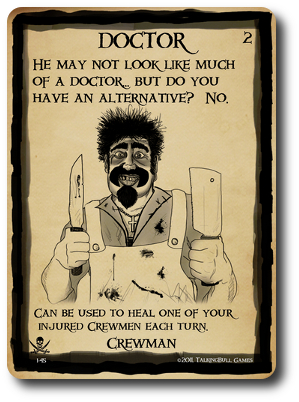
Optionally, a player can pay one Piece of Eight to repair all damage to the ship or heal all crew members. Doing so, however, immediately ends the player’s turn after step 2.
Step 3: Draw a Card
The Game deck contains cards that can help or hinder a player and their attempt to become one of the world’s most notorious pirates. But being a pirate means taking risks. A player draws a card from the Game deck and shows it to all players. Depending on what the card is, the player will take different actions.
If the card drawn is a Raid card, the player is forced by the Pirate Code to raise their colors and attempt to raid whatever location or ship they have bumped into. Even if it means going up against an opponent they could not possibly win against. Of course, there are cards available that will allow the player to avoid a raid if they don’t want to get in a tumble. If the player is unable to go on the raid or is able to ignore it, the card is put in the discard pile, face-up. Otherwise, prepare the cannons! See step 4 for details
If the card drawn is a Crewman, Supplies, or an Event card, the player can put it in their hand or play it. Note that some Event cards will have a hand icon on them and some do not. If the Event card does not have the hand icon, it must be played when it is drawn and cannot be held in the player’s hand.
Step 4: Declare a Raid or Play a Card
If a Raid card was not drawn during step 3, and the player has a Raid card in their hand, they can now play it and go on the raid. All Raid cards have instructions on how to determine if a raid is successful. Opponents can play Event cards that will more than likely make the raid more difficult.
Combat is quickly resolved by rolling dice and the player adding to the rolled value their crew’s strength that are not currently occupied doing other things (like being a doctor or fixing the ship). Some supplies can also help, the player can equip certain pirate items on their crew, and some crew members give bonuses beyond their strength value. An opponent will roll for whatever the target is. Sometimes, however, dice are not used. In which case, the total of the crew is used only. It is also important to note that the captain of the ship does not engage in battle unless they have a reliable crewman they can turn the ship over to.
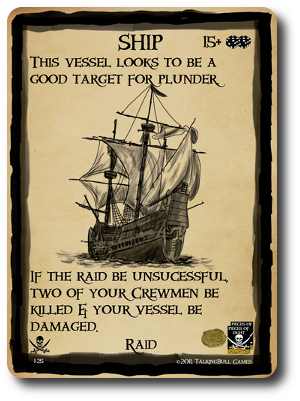
If the player’s total combat value is higher than the target’s value, they are successful and collect the prize noted on the Raid card. If the prize is a Piece of Eight, it is collected and placed in front of the player. If the player’s total combat value is less than the target of the raid, they failed and suffer the consequences noted on the Raid card. If the values are equal, it is a tie and the player does not succeed or fail. Regardless, the Raid card is place in the discard pile.
Sometimes failure will be damage to the ship and crew. Damage to the ship is placed on the Captain card and damage to the crew is placed on whatever crewman the player likes. Injured crewman cannot attack or defend until healed and for every damage taken to the ship, the captain and the crew suffer -1 to their attack and defense during combat. Sometimes failure will mean losing a Piece of Eight or losing crew, too.
Of course, if the player decides not to raid (an excellent idea if the ship is poorly equipped), they can play one Supply, Crewman, or Event card from their hand.
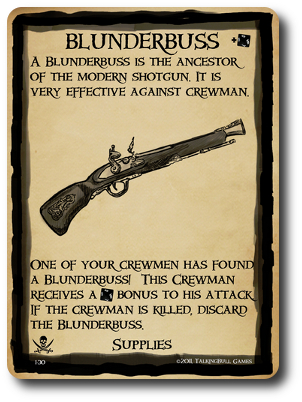
Step 5: Discard
The final step is to discard down to 5 cards. By default, 5 cards is the hand limit, but there are cards available that can be played that increase this limit. What cards are discarded are up to the player to determine. These are placed in the discard pile.
When the player’s turn is over, the next player going clockwise now has their turn starting with step 1 above.
Legend of the High Seas
As the game progresses, players will gain Pieces of Eight through successful raids and sometimes just finding them as rewards in the Game deck. Once a player wins their eighth Piece of Eight through a raid (it cannot be given by a card for free), they automatically win the game, retire to a private island, and live out the rest of their lives surrounded by treasure. Not a bad way to end a career of pillaging, murdering, and otherwise being a real nuisance to others.
Game Variants
There are two game variants available to use if the player’s want to change the standard game. They are summarized her.
- Come to My Aid: This game variant allows one player to pay a Piece of Eight for another player to send in their ship and crew to assist in raids. Both of the player’s total their scores and add them together. If the raid is successful, only the player who initiated the raid gets whatever rewards are presented. If the raid fails, both players are penalized and suffer the negative affects. Regardless, the player who is assisting gets their Piece of Eight (but they should probably ask for it up front).
- Smaller Goal: This game variant allows the players to reduce the number of Pieces of Eight necessary to win the game. For example, from 8 to 6 pieces.
To learn more about Pieces of Eight – Steal the Booty! Drink the Rum! deluxe edition and read the full rules, visit the game’s web page on the Game Crafter.
Prediction
It would be incorrect to suggest that Pieces of Eight is Munchkin on a boat, although I’m sure the comparison will be made. The game play is very straightforward, simple, and random. Much of the chaos often caused by randomness is greatly reduced, however, with the players being given the ability to hold cards in their hand. This takes the game from being just a simple action/reaction type of game experience to a slightly more in-depth hand management experience. But not by much. Just enough, I think, to make it palatable to the Gamer Geeks, but still very enjoyable and fast for the Child and Parent Geeks.
I should note that the game has images and card text that suggest alcohol consumption, violent sword play, being torn apart by sharks, wenches, and disease. Or, in other words, exactly what you’d expect the life of a pirate to contain. The artwork throughout is humorous (and slightly inconsistent), but it never once made my 5-year-old flinch. Which, now that I think about it, might say more about my 5-year-old than anything about the game. Long story short, the game is all about pillaging and raiding. Not raping, whoring, or anything of extreme violence. A pirate does appear to be picking his nose really, really hard, though…
The game only has four different cards. These are Supplies, Events, Raids, Crewmen, and Captains. Five. Five different cards and what a player can do with them is pretty well described on each. This makes teaching the game very simple, but it is impossible to cover all the things that can or cannot be done in the game. This is where the game designer proves to everyone that he is a certified genius. Players must always show the card they drew during step 3. This is a great opportunity to discuss and ask questions about the card. The only time players do not show their card is when they are directed to do so when winning a raid or through another card action. Of course, players can always ask questions about the cards, even if they were drawn without the other player’s knowing what it is. The game is simply not deep enough to get all worked up about keeping cards super top secret. Game play is too fast and cards in hand are quickly collected and spent, like gold through a pirate’s fingers.
See what I did there?
And so, having pitched and explained the game to my 8-year-old, we were ready to have our first game. He’s played games like Pieces of Eight before and felt very comfortable with it after only a 5 minutes explanation with a few examples. As I gave him the Captain deck to look through, I asked him his thoughts on Pieces of Eight so far.
“Looks fast and fun. You know I like pirates and this game looks like it is full of them? Are there any Ninjas?” ~ Liam (age 8)
No there are not. Let’s cast off and see if this game can hold its own as it’s being tossed and turned with our testing or sinks like a rock (glub-glub-glub).
Final Word
Pieces of Eight was a huge success with the Child Geeks. There must be something terribly exciting about collecting large plastic fake gold pieces that adults can’t understand. Every time my little geek and any Child Geek was awarded a Piece of Eight, they practically exploded out of their chair. Between the explosions, the game was found to be fun and exciting. The many different cards kept the games interesting and different. It was clear just by observing that the player who paid the most attention to building their crew always had a better chance of winning the game and was also the most frequently targeted by other players. The constant back and forth would have become old if it weren’t for the forced raids that kept those type of player versus player shenanigans to a minimum. The end result was a pirate themed card game that the Child Geeks would be happy to crew anytime.

My little geek pirate reviews his card after a successful raid on a small town
The Parent Geeks were less enthused about the game, but very much enjoyed it. Seriously, I wish I would have video recorded some of the Child Geeks’ reactions to getting a Piece of Eight or even winning the game. It was like 4th of July and Christmas Day all at once. Epic. But despite the lack of epicness shown by the Parent Geeks, they all agreed it was a fast and fun casual game they did and would continue to enjoy playing. They liked how players were in combat indirectly (most of the time), and of course, the nonsense that is pirates strongly represented in the game’s theme and game play. The Parent Geeks voted to approve the game for how easy it was to play with the family and friends.
Gamer Geeks enjoyed the game but weren’t ready to write sonnets about it. To them, Pieces of Eight played similar to Munchkin (called it!), but was different enough in both theme and game play to be judged on its own merit. After several games, the Gamer Geeks suggested that the game is perfect for casual game play, great for quick games, pre-game night starters, or that last game of the night. There was enough logical thinking to keep the Gamer Geeks engaged, but little to no strategy or tactics. That was fine, as the Gamer Geeks understood that not every game that is put in front of them needs to make their brain hurt. What a game must do, however, is challenge, engage, and entertain. Which, the Gamer Geeks decided, Pieces of Eight did.
Oh, I like this game, but a word of caution. After you play the game 12 or more times in a row, it starts to get pretty dull. There are only so many cards and only so many ways to use them. But the number of times I played the game is highly abnormal and I doubt anyone would play this game more than a few times a month. Regardless, the game has a lot of replay value. With 120 cards (and an expansion available), there are many different ways the game can go and each game is different, providing a high level or replayability. The end result is a very enjoyable, fast, and fun casual game that appealed to all three of our groups, despite some of them thinking that Ninjas were superior.
This game was given to Father Geek as a review copy. Father Geek was not paid, bribed, wined, dined, or threatened in vain hopes of influencing this review. Such is the statuesque and legendary integrity of Father Geek.




Pingback: Pieces of Eight – Buccaneers Game Expansion Review » Father Geek
Where can this game be purchased ?
You can purchase this game from The Game Crafter.